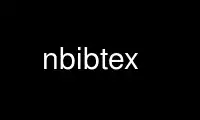
This is the command nbibtex that can be run in the OnWorks free hosting provider using one of our multiple free online workstations such as Ubuntu Online, Fedora Online, Windows online emulator or MAC OS online emulator
PROGRAM:
NAME
nbibtex - make a bibliography for LaTeX
SYNOPSIS
nbibtex [options] auxname[.aux] [bibname...]
DESCRIPTION
NbibTeX is a drop-in replacement for BibTeX. It reads the top-level auxiliary (.aux) file
that was output during the running of latex(1) or tex(1) and creates a bibliography (.bbl)
file that will be incorporated into the document on subsequent runs of LaTeX or TeX.
NbibTeX looks up, in bibliographic database (.bib) files specified by the \bibliography
command, the entries specified by the \cite and \nocite commands in the LaTeX or TeX
source file. The association of \cite command with .bib entry is made by a simple query
language described below. NbibTeX formats the information from the .bib entries according
to instructions in a bibliography style (.nbs) file (specified by the \bibliographystyle
command, and it outputs the results to the .bbl file.
If the optional bibnames are used, NbibTeX looks in the named bibliographies instead of
those specified by the \bibliography command. A bibname without a slash (/) character
means the same thing it would mean in a \bibliographystyle command: it is looked up
according to the rules of BibTeX. A bibname with a slash character is taken to be the
absolute or relative pathname of a .bib file. Explicit bibnames can be used with the -bib
and -o options to make a paper-specific .bib file from larger .bib files.
The LaTeX manual explains what a LaTeX source file must contain to work with NbibTeX.
Appendix B of the manual describes the format of the .bib files. The `NbibTeXing' document
describes extensions and details of this format, and it gives other useful hints for using
NbibTeX.
OPTIONS
-min-crossrefs=number
The -min-crossrefs option defines the minimum number of crossref required for
automatic inclusion of the crossref'd entry on the citation list; the default is 2.
-terse Accepted for backward compatibility with BibTeX; NbibTeX is terse by default.
-permissive
Enables NbibTeX to continue working even when some of the .bib files mentioned in
the \bibliography command are missing. Also tells NbibTeX not to object if
duplicate entries are found in multiple .bib files.
-strict
Tells NbibTeX to complain about all irregularities it spots in any .bib file it
parses. By default, NbibTeX (like BibTeX) complains only about entries it
actually intends to use.
-o file
Writes the bibliography to file instead of to the default auxname.bbl. If file is
-, writes to standard output.
-bib Instead of writing a bibliography for use by LaTeX, writes exactly those NbibTeX
entries needed by auxname. Useful for making paper-specific .bib files.
-help Emit a short help message and exit.
-version
Emit version information and exit.
EXAMPLES
To make a normal bibliography for file paper.tex:
nbibtex paper
To use the personal .bib file personal.bib to make a paper-specific bibliography for file
paper.tex, which should use the command lography{paper}:
nbibtex -o paper.bib -bib paper personal
The file personal.bib should be found on the usual BIBINPUTS path.
To extend the bibliography paper.bib by filling in missing entries from personal.bib:
nbibtex -permissive -o paper.bib -bib paper paper personal
QUERY LANGUAGE
To specify a paper you wish to cite, classic BibTeX requires an arbitrary key. The
advantage of NbibTeX is that you cite a paper by the contents of the NbibTeX entry.
The citation consists of a sequence of one or more constraints separated by colons.
A constraint may be empty.
A nonempty constraint is of the form key=words, where key is the name of a field in
the NbibTeX entry and words is a sequence of one or more words separated by dashes.
The contraint is satisfied if every word in words is found in the field named by
key. (The key may also be [type], which matches agains the type of the entry, or
*, which looks for words in any field.)
For example, the following queries might match an entry for a useful source on arithmetic:
author=knuth:series=art-programming:volume=2
author=knuth:title=seminumerical:year=1981
As a convenience, keys may be defaulted in up to three constraints. In the first
constraint, the default key is author (or if there is no author, editor). In the second
constraint, the default key is year if words is all digits, and is title otherwise. In
the third constraint, the default key is year if words is all digits, and is [type]
otherwise. So for example, we could have written
knuth:seminumerical:1981
To match a word in words, ΒX uses the Boyer-Moore string-matching algorithm, so longer
words are usually faster.
NbibTeX's query language can be used on the command line by nbibfind(1).
NBIBTEX STYLES AND COMPATIBILITY WITH BibTeX
Like BibTeX, NbibTeX supports a variety of "styles" of bibliography. Each style is
defined by a program written in Lua, using additional primitives suitable to construction
of bibliographies. NbibTeX provides the three standard styles in a form suitable for use
with the natbib package. Two of these styles (abbrvnat and unsrtnat) are completely
compatible with the corresponding BibTeX styles; the third style (plainnat) has been
changed to more closely follow the Chicago Manual of Style. A compatible version is
available as style plainnatc.
Additional styles may be created by writing new Lua code; for example, an author wishing
to create a style called mcbride would put a file called mcbride.nbs (for New BibTeX
Style) in the directory /usr/share/nbibtex. For guidance on what goes into such a file,
consult the other files in that directory and the literate source code for NbibTeX.
ENVIRONMENT
For .bib files, NbibTeX searches the directories in the path defined by the BIBINPUTS
environment variable if that is set, otherwise the default. For details of the searching,
see tex(1) and kpsewhich(1).
No special searching is done for the .aux file.
Use nbibtex online using onworks.net services
